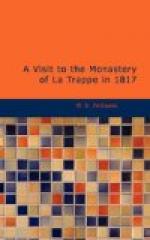[Footnote 10: A tract of about 150 miles square, at the mouth and on the southern bank of the Loire, comprehends the scene of those deplorable hostilities. The most inland part of the district, and that in which the insurrection first broke out, is called Le Bocage; and seems to have been almost as singular in its physical conformation, as in the state and condition of its population. A series of detached eminences, of no great elevation, rose over the whole face of the country, with little rills trickling in the hollows and occasional cliffs by their sides. The whole space was divided into small enclosures, each surrounded with tall wild hedges, and rows of pollard trees; so that though there were few large woods, the whole region had a sylvan and impenetrable appearance. The ground was mostly in pasturage; and the landscape had, for the most part, an aspect of wild verdure, except that in the autumn some patches of yellow corn appeared here and there athwart their green enclosures. Only two great roads traversed this sequestered region, running nearly parallel, at a distance of more than seventy miles from each other. In the intermediate space, there was nothing but a labyrinth of wild and devious paths, crossing each other at the extremity of almost every field—often serving, at the same time, as channels for the winter torrents, and winding so capriciously among the innumerable hillocks, and beneath the meeting hedge-rows, that the natives themselves were always in danger of losing their way when they went a league or two from their own habitations. The country, though rather thickly peopled, contained, as may be supposed, few large towns; and the inhabitants, devoted almost entirely to rural occupations, enjoyed a great deal of leisure. The noblesse or gentry of the country were very generally resident on their estates, where they lived in a style of simplicity and homeliness which had long disappeared from every other part of the kingdom. No grand parks, fine gardens, or ornamented villas; but spacious clumsy chateaux, surrounded with farm offices and cottages for the labourers. Their manners and way of life, too, partook of the same primitive rusticity. There was great cordiality, and even much familiarity, in the intercourse of the seigneurs with their dependants. They were followed by large trains of them in their hunting expeditions, which occupied so great a part of their time. Every man had his fowling-piece, and was a marksman of fame or pretensions. They were posted in various quarters, to intercept or drive back the game; and were thus trained, by anticipation, to that sort of discipline and concert, in which their whole art of war was afterwards found to consist. Nor was their intimacy confined to their sports. The peasants resorted familiarly to their landlords for advice, both legal and medical; and they repaid the visits in their daily rambles, and entered with interest into all the details of their agricultural




